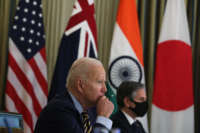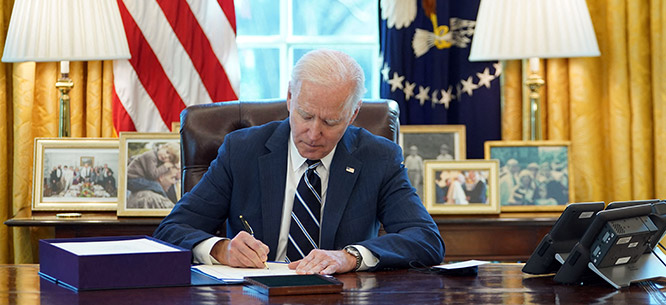
The unprecedented pandemic, and the recession it has caused, has led to a sharp increase in food insecurity in the United States. The problem isn’t that there isn’t enough food to go around, but that more and more people are unable to afford to purchase it. Last year the United Nations World Food Program (WFP) recently released a report predicting that the number of people facing extreme hunger could soar to 270 million by the end of 2020 — effectively doubling.
What’s leading to these extreme statistics isn’t a lack of availability — it’s that many people simply can’t afford to purchase food. Like with many commodities, capitalist markets are fairly good at producing food, but they are not so efficient at distributing it equitably. When you combine this with a lack of bold intervention from policymakers, it’s no surprise that we’re seeing an uptick in hunger during the pandemic.
Hunger is not the only food-related problem intensifying under capitalism. COVID-19 has simply magnified many of the already existing problems in our food system, such as labor exploitation, unsustainable farming practices, lack of regulation… the list goes on.
In his book, A Foodie’s Guide to Capitalism: Understanding the Political Economy of What We Eat, Eric Holt-Gimenez gives a broad overview of how we got to our current predicament when it comes to how we produce, distribute and consume food in the United States. The following transcript has been lightly edited for clarity.
Robert R. Raymond: I wanted to start by situating our conversation within our current major crisis. Can you explain how the pandemic has impacted our food system?
Eric Holt-Giménez: I think one of the most remarkable things about what COVID has done to the food system is that it has helped to perpetuate it as it is. I mean, I don’t think that COVID has significantly changed our food system at all other than to exacerbate some of the inequities and externalities. And what I mean by that is, when the lockdowns first hit, there was tremendous disruption to the food supply chain globally, especially in the United States. Restaurants were closing, food wasn’t being sold to restaurants, and food wasn’t being distributed to schools and other institutions. It was backing up all the way down the supply chain.
We also began to see that food and farmworkers were some of the first to get seriously ill, in large part because our processing plants, especially meat processing plants, were refusing to shut down and to socially distance — basically calculating that there were enough poor immigrant workers that they could draw from. They could simply sacrifice the workers that they had because there’s always someone to take their place. So, tremendous disruptions in the food supply chain, but it adjusted itself very quickly, actually. We don’t see scarcities now — there was some panic-buying at first, but once that was over with we didn’t really see scarcities in the United States or on a global scale. There’s plenty of food to go around.
But what we do see is the people who work within the food system are sick, dying, out of work and food insecure. Now, this was true before COVID, but it’s worse now. We also see a tremendous concentration going on in the industry as before but worse. Huge conglomerates like Walmart and Amazon have actually, and unsurprisingly, made a killing with COVID. People are ordering food; people are stocking up. So, I would say that it hasn’t significantly changed our food system at all — it’s made parts of it worse for a lot of people along with the economy. But basically, it’s more of the same.
Zooming out, I think it would be helpful to take a historical look at our food system to understand how we got to where we are now. One of the earlier examples of how we’ve come to commodify food is based around the potato famine. Can you explain what happened during that crisis?
The Irish potato famine, also known as the Great Hunger of 1845, has some very interesting and horrifying explanations which fly in the face of the Malthusian understandings, which are still peddled around the world today in terms of hunger and famine. In other words, Thomas Malthus, an English economist, came up with a theory that people go hungry because there’s not enough food. This has almost never been the case, and a good example is the Irish potato famine.
What happened was that the Spanish brought back potatoes from Latin America, and from the 1,200 or so varieties of potatoes from the Andes, they brought back just a couple. The potato made its way around Europe because it was so much more efficient in terms of producing the calories that people needed. But what happened in Ireland was there was only one variety of potato, and it became infested with a strain of fungus that spread very quickly throughout country. And in the course of seven years, I believe, it destroyed three-quarters of the potato crop.
This was devastating because most Irish people ate mostly potatoes. Now, why did most Irish people eat mostly potatoes? Because they had been colonized by the British, and British landowners controlled most of the land in Ireland. Most of the Irish were sharecroppers — they didn’t own their land and subsisted on potatoes. So, what at one point was the bulwark of the Indian civilization becomes, in fact, food for exploited peoples who are very vulnerable and on the brink of disaster anyway…. What’s interesting is that, the potato fungus alone would not have led to the famine. But because the people were too poor to buy food, food was actually being exported out of Ireland during the height of the famine. That’s why so many people starved. So, you can see right there that food had become a commodity, it followed the logic of the market, and the Great Hunger is an example that really helps explain what’s still wrong with the capitalist food system today.
One of the main problems with our food system isn’t that there’s not enough food to go around — it’s how that food is distributed. Can you talk about the problems with the Green Revolution of the 1970s and how the ideas it was premised on still permeate the food system today?
The driving force behind the “Green Revolution” was not hunger at all — it was the need for agro-industry to find new markets for their products. In 1968, Paul Ehrlich wrote The Population Bomb, which posited that the world population was exploding, that we need to double production over the next generation, and we will need to limit population growth. And so the Green Revolution was introduced, and what it did was basically to take the fertilizers and pesticides that the United States had been using after World War II and export them around the world, to get other countries and farmers to buy them and increase production.
So that’s why we supposedly need genetically modified organisms; that’s why we supposedly need precision farming, satellite agriculture, all these things — because supposedly the population is growing so fast that we need to produce more food. Well, it doesn’t appear as though anybody is groveling before the facts on this, because the rate of population growth has plummeted. The world population is crashing, and it doesn’t look like we’re even going to reach the 12 billion which was projected just a couple of years ago. Now it looks like 8 or 9 billion is going to be the leveling off for the population. So, you can’t argue that we need to double production because we already produce too much to begin with. And yet, this is what we hear over and over again. So, this is really sort of how capital politicizes the discourse around hunger in order to colonize new markets.
You alluded to this earlier, but can you talk a bit about the problem of overproduction?
We produce too much food. And when we produce too much food, we do so because we don’t have to pay for what it’s worth. We don’t have to pay for the destruction that it causes in the environment — at least the agricultural sector doesn’t have to. And what happens in agriculture is that farmers have to invest a tremendous amount of resources and money in time upfront before they see any returns. And then you have to wait and pray for months for a crop and favorable market conditions and favorable weather conditions and whatnot. And then you pay back your loans and hopefully you make a profit. Well, most years you don’t, but you’re counting on those years that you do.
But if the price goes down, what are you going to do? Farmers produce more, because they have a lot of fixed costs, upfront costs. So, they produce more than next year to recover their losses. Well, if you produce more, that just creates more overproduction and the price goes lower again. And we basically had overproduction for the last hundred years. If you look at the food price index, it’s been dropping ever since before World War II. And what that means is there’s always been too much food, and that’s still the case today.
Can you talk about the various forms of labor exploitation that take place in the capitalist food system today, particularly in the agricultural sector?
Well, one of the biggest ways in which the agricultural sector avoids labor laws, regulation, and scrutiny is by hiring people who are undocumented and who fall outside of the system. They hire people who are vulnerable and are not able to easily challenge abuses on the farm — who are technically not even able to form unions. Our food system would fall apart tomorrow without immigrant and undocumented labor. We wouldn’t get the products out of the fields, we wouldn’t get anything processed in the plants. And to a large degree, we wouldn’t get our food served or cooked.
So the biggest challenge for labor in agriculture today is immigration. And, ironically, it was President Ronald Reagan who gave the last amnesty. And the minute folks got amnesty, they got the hell out of agriculture — they just didn’t want to be farmworkers anymore. And, so, the point is that on one hand, we need to regularize immigration status for workers, and then we have to begin applying fair, equitable labor regulation to agriculture and have them begin paying farmworkers a fair wage — not just a living wage but a fair wage.
You’ve spoken about how it’s time for “foodies” to embrace a Green New Deal for the food system. Can you talk about what you mean by this?
The food system is still pivotal in terms of our entire political economic system. And I say that recognizing that we can’t change the food system without changing the system of capitalism — it’s going to be impossible to change one without changing the other — they’re interlinked. But the food system has tremendous leverage in the types of social and economic transformations which we need in this country and in the world.
We need to go back to the lessons from the original New Deal and update them to include provisions around labor, around race, reparations and around the environment. So, in some ways, it’s very simple. You say to the farmer, ok, we will buy X tons of wheat or corn, whatever it is at this price, which is a fair price, but we won’t buy one bushel more. And that’s basically a quota. And so, you get to produce this much, and we can figure it out with the parity price index — this is how much you need to make a good living. But you cannot contaminate your groundwater, you can’t poison your workers, you have to pay them fairly. In other words, a set of social and environmental conditions for a guaranteed price at a level of production which we can actually absorb. That way, the price won’t drop too much and we can put some in reserve.
If we start there, you would find a number of things happening. You will find that these large industrial farms will not be able to compete. A Green New Deal with a green and fair-parity index will favor family farms, and the wealth from those farms will circulate locally and help to rebuild our rural communities that are suffering so much. There are studies that show that that type of wealth circulates up to seven times more within the community if it’s not siphoned off by agribusiness and by some of these huge monopolies.
So that means that the food movement, per se, particularly the farm justice movement and food justice movement, have to build alliances, broad alliances. That also means building alliances and taking action outside of just the food system. There are a whole host of issues which impact the food system, particularly around climate and environment and labor, with whom we need to build alliances in order to create the political will to introduce the type of transformative legislation and policies which we desperately need.
This post was originally published on Latest – Truthout.





